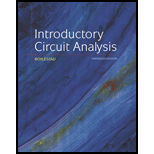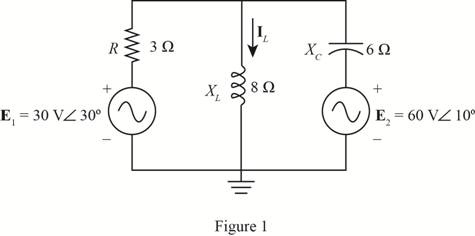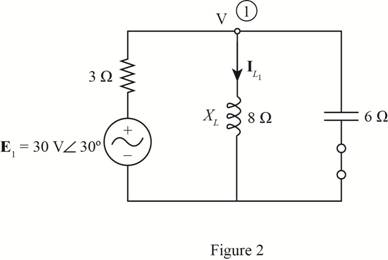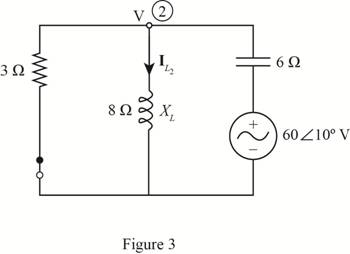
Using supeerposition, determine the current through the inductance XL for the network of Fig. 19.105.

The current flowing through the inductance XL of the given circuit.
Answer to Problem 1P
The current through the inductor is IL=6.1∠−32.11° A.
Explanation of Solution
Given:
The given circuit is shown in Figure 1.

Calculation:
To apply superposition theorem, first consider the effect of voltage source E1 and replace the source E2 by a short circuit.
The required diagram is shown in Figure 2.

Let the voltage at node 1 is V. Apply KCL at node 1.
V−30∠30°3+Vj8+V−j6=0(13+1j8+1−j6)V=30∠30°3(0.333+j0.0417)=10∠30°V=29.77∠22.87° V
The current through the inductor is given by
IL1=Vj8
Substitute 29.77∠22.87° for V in the above equation.
IL1=29.77∠22.87°j8=3.72∠−67.12° A
Now consider the effect of source voltage E2 and replace the source voltage E1 by short circuit.
The required diagram is shown in Figure 3.

Apply the KCL at node 2.
V3+Vj8+V−60∠10°−j6=0(13+1j8+1−j6)V=60∠10°−j6(0.333+j0.0417)=10∠100°V=29.77∠92.87° V
The current through the inductor is given by,
IL2=29.77∠92.87°j8=3.72∠2.87° A
Therefore, according to super position theorem the current through the inductor is given by
IL=IL1+IL2
Substitute 3.72∠−67.12° A for IL1 and 3.72∠2.87° A for IL2 in the above equation.
IL=3.87∠−67.12°+3.87∠92.87°IL=6.1∠−32.11° A
Conclusion:
Therefore, the current through the inductor is I=6.1∠−32.11° A.
Want to see more full solutions like this?
Chapter 19 Solutions
Introductory Circuit Analysis (13th Edition)
- 確定圖5-38中的I1、I2和IB。 Vcc=-12 V;R1=33 kN;RC=1.8 kN;βDC = 150;RE=560;R2=5.6 kN 圖 5-38arrow_forwardConsider the following circuit: Vs R₁ Vx ww C'₁ R2 Where Vs = 3.3 cos(2000t-10) VR:=2202 R2 = 1002,L=1mH, Ci = 22 nF, C2 = 47 nF N.B. We have been using cosine as the basis for our phasors. 1. What is the impedance of each of R, Ci, L (answer to within 1%): Z RI = +j Q Zci= +j QZL= +jQ 心 2. Complete the following KCL for node Vo, assuming current flowing out of the node is positive (answer to within 1%): 0= +j )+Vo/ +j0)+Vo/(0+j 回回回 3. Hence or otherwise solve for Vo in phasor form (answer to within 1% amplitude and 5 degrees of phase): Vo = ° V 回 4. Convert this phasor to a time domain expression for Vo(t) (answer to within 1% amplitude and 5 degrees of phase): Vo(t) = cos( t+ Vo 1arrow_forwardis pf leading, lagging or neither?arrow_forward
- *please use pen and paper to show work (thank you!!!)* Design a synchronous binary up-counter using 4 negative edge-triggered JK flip-flops provided with a clock. The states (sequences) 1100, 1001 and 1000 are considered as unused states. (i) Draw the state diagram of the counter. (ii) Build the counter’s state table showing the synchronous inputs of the JK flip-flops as well. (iii) Using Karnaugh-maps, find the minimal sum-of-products (SOP) form of the equations for the inputs to the flip-flops; assume the next states of the unused combinations to be <don’t care states=. (iv) Draw the logic circuit of the counter.arrow_forwardSolve this problem and show all of the workarrow_forwardDesign a fuel-cell – Supercapacitor hybrid locomotive with 640 horsepower and a traveling range of 500 km per fully charged hydrogen tank, and consumption rate of 500 Wh/km. The fuel cell provides the driving range and supercapacitor captures the regenerative breaking energy to run the accessories. Assume fuel cell efficiency at 50%. 1hoursepower = 750 W Calculate the size (volume in liter) of a pressurized hydrogen storage tank at 700 bar pressure to deliver the traveling range for the vehicle. Fuel cell voltage at the cell level is 1V. Calculate the volume of solid-state hydrogen storage tank for the vehicle if the solid NaAlH4 is used as a hydrogen storage material. The density of NaAlH4 is 2.8 g/cm3. Atomic weights: Na=23g, Al=27g, and H=1g Calculate the total amount of platinum catalyst loading inside the fuel cell stack, and cost of catalyst if Pt cost as $30/g. Assume catalyst loading on the anodes at 0.02mg/cm2 and 0.04mg/cm2 on the…arrow_forward
- 4. Design an operational amplifier circuit to implement the following mathematical equation. 0.25 dv dtt dvo + ·+ V₁ = Vi dtarrow_forwardsolve and show workarrow_forwardProblem 4 Consider a unity (negative) feedback system whose open-loop transfer function is given by K(s+1)(s+2) G(s): s(s +10) Assume K = 1. (a) What is the type of the system? (b) Find static position error constant Kp, static velocity error constant Ky and static acceleration error constant Ka (c) Find the steady state-error of the system for following each of the following inputs. (i) (!!) t³ 1(t) (t+2) 1(t) (d) Find the range of K, for which steady-state error of the system for ramp input will be less than 0.05?arrow_forward
- An inner-city metro-bus weighs approximately 10,000 kg including passenger loads, travels 500 km per fully charged battery, and consumes 420 Wh/km. Design a lithium-ion battery pack for the metro-bus using newly developed cells made of silicon anode and lithium manganese-iron phosphate (LMFP) with formulation of Si // 4(LiMn5Fe0.5PO4). The cell average voltage is 3.5V and its capacity 4Ah. The nominal battery pack voltage is 350V. Report the battery pack configuration: Calculate the amount of silicon and LMFP cathode that is required for a single cell at 4Ah capacity. Atomic weight of elements in gram: Si=28 , Li=7, Mn=55, Fe=56, P=31, and O=16. If the building block cell is designed in a cylindrical format (2cm diameter and 10 cm height), calculate the energy density (Wh/lit) and specific energy (Wh/kg) at the cell level and at the battery pack level. Assume cell weight 100g, and cells are arranged in two layers in the battery pack with top…arrow_forwardProblem 2 Consider the following feedback control system. (i) (ii) K(s+2) s(s + 1)(s+3) 5+6 5+7 Use Routh-Hurwitz criterion to find the range of K for which the closed-loop system is stable. Using the Routh table from part (a), find the range of K for which the closed-loop system will have one pole in the ORHP and rest of the poles in the OLHP. This implies there will be only one sign changes in the 1st column.arrow_forwardProblem 3 Consider the following system where x(t) denotes displacement of the mass from its equilibrium position and u(t) denotes the force applied to the mass. 28 N/m -0000-5 kg. u(t) -x(t) 5 N-s/m (a) Find the transfer function of the system. (b) Is the system internally stable (marginally or strictly) and BIBO stable? (c) Find the settling time, rise time, peak time and percent overshoot for the step-response of the system.arrow_forward
 Introductory Circuit Analysis (13th Edition)Electrical EngineeringISBN:9780133923605Author:Robert L. BoylestadPublisher:PEARSON
Introductory Circuit Analysis (13th Edition)Electrical EngineeringISBN:9780133923605Author:Robert L. BoylestadPublisher:PEARSON Delmar's Standard Textbook Of ElectricityElectrical EngineeringISBN:9781337900348Author:Stephen L. HermanPublisher:Cengage Learning
Delmar's Standard Textbook Of ElectricityElectrical EngineeringISBN:9781337900348Author:Stephen L. HermanPublisher:Cengage Learning Programmable Logic ControllersElectrical EngineeringISBN:9780073373843Author:Frank D. PetruzellaPublisher:McGraw-Hill Education
Programmable Logic ControllersElectrical EngineeringISBN:9780073373843Author:Frank D. PetruzellaPublisher:McGraw-Hill Education Fundamentals of Electric CircuitsElectrical EngineeringISBN:9780078028229Author:Charles K Alexander, Matthew SadikuPublisher:McGraw-Hill Education
Fundamentals of Electric CircuitsElectrical EngineeringISBN:9780078028229Author:Charles K Alexander, Matthew SadikuPublisher:McGraw-Hill Education Electric Circuits. (11th Edition)Electrical EngineeringISBN:9780134746968Author:James W. Nilsson, Susan RiedelPublisher:PEARSON
Electric Circuits. (11th Edition)Electrical EngineeringISBN:9780134746968Author:James W. Nilsson, Susan RiedelPublisher:PEARSON Engineering ElectromagneticsElectrical EngineeringISBN:9780078028151Author:Hayt, William H. (william Hart), Jr, BUCK, John A.Publisher:Mcgraw-hill Education,
Engineering ElectromagneticsElectrical EngineeringISBN:9780078028151Author:Hayt, William H. (william Hart), Jr, BUCK, John A.Publisher:Mcgraw-hill Education,





